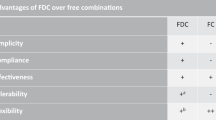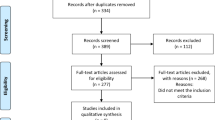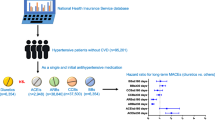Abstract
The aim of the study was to analyze the clinical use of different types of combination therapy in a large sample of consecutive patients with uncontrolled hypertension referred to Hypertension Centre. We performed a retrospective analysis of combination antihypertensive therapy in 1254 consecutive patients with uncontrolled hypertension receiving at least triple-combination antihypertensive therapy. Among the most prescribed antihypertensive classes were renin-angiotensin blockers (96.8%), calcium channel blockers (82.5%), diuretics (82.0%), beta-blockers (73.0%), centrally acting drugs (56.0%) and urapidil (24.1%). Least prescribed were spironolactone (22.2%) and alpha-1-blockers (17.1%). Thiazide/thiazide-like diuretics were underdosed in more than two-thirds of patients. Furosemide was prescribed in 14.3% of patients treated with diuretics, while only indicated in 3.9%. Inappropriate combination therapy was found in 40.4% of patients. Controversial dual and higher blockade of renin-angiotensin system occurred in 25.2%. Incorrect use of a combination of two antihypertensive drugs with the similar mechanism of action was found in 28.1%, most commonly a combination of two drugs with central mechanism (13.5%). In conclusion, use of controversial or incorrect combinations of drugs in uncontrolled hypertension is common. Diuretics are frequently underdosed and spironolactone remains neglected in general practice. The improper combination of antihypertensive drugs may contribute to uncontrolled hypertension.
This is a preview of subscription content, access via your institution
Access options
Subscribe to this journal
Receive 12 digital issues and online access to articles
$119.00 per year
only $9.92 per issue
Buy this article
- Purchase on Springer Link
- Instant access to full article PDF
Prices may be subject to local taxes which are calculated during checkout


Similar content being viewed by others
References
Cífková R, Škodová Z, Bruthans J, Holub J, Adámková V, Jozífová M et al. Longitudinal trends in cardiovascular mortality and blood pressure levels, prevalence, awareness, treatment, and control of hypertension in the Czech population from 1985 to 2007/2008. J Hypertens 2010; 28 (11): 2196–2203.
Nwankwo T, Yoon SS, Burt V, Gu Q . Hypertension among adults in the United States: National Health and Nutrition Examination Survey, 2011-2012. NCHS Data Brief. Centers for Disease Control and Prevention: Hyattsville, MD, USA, Number 133, October 2013; pp 1–8.
Joffres M, Falaschetti E, Gillespie C, Robitaille C, Loustalot F, Poulter N et al. Hypertension prevalence, awareness, treatment and control in national surveys from England, the USA and Canada, and correlation with stroke and ischaemic heart disease mortality: a cross-sectional study. BMJ Open 2013; 3 (8): e003423.
Kotseva K, Wood D, De Backer G, De Bacquer D, Pyorala K, Reiner Z et al. EUROASPIRE III. Management of cardiovascular risk factors in asymptomatic high-risk patients in general practice: cross-sectional survey in 12 European countries. Eur J Cardiovasc Prev Rehabil 2010; 17 (5): 530–540.
Mancia G, Fagard R, Narkiewicz K, Redon J, Zanchetti A, Bohm M et al. 2013 ESH/ESC Guidelines for the management of arterial hypertension: the Task Force for the management of arterial hypertension of the European Society of Hypertension (ESH) and of the European Society of Cardiology (ESC). J Hypertens 2013; 31 (7): 1281–1357.
Calhoun DA, Jones D, Textor S, Goff DC, Murphy TP, Toto RD et al. Resistant hypertension: diagnosis, evaluation, and treatment. A scientific statement from the American Heart Association Professional Education Committee of the Council for High Blood Pressure Research. Hypertension 2008; 51 (6): 1403–1419.
Hanselin MR, Saseen JJ, Allen RR, Marrs JC, Nair KV . Description of antihypertensive use in patients with resistant hypertension prescribed four or more agents. Hypertension 2011; 58 (6): 1008–1013.
Persell SD . Prevalence of resistant hypertension in the United States, 2003-2008. Hypertension 2011; 57 (6): 1076–1080.
Rosa J, Zelinka T, Petrák O, Štrauch B, Šomlóová Z, Indra T et al. Importance of thorough investigation of resistant hypertension before renal denervation: should compliance to treatment be evaluated systematically? J Hum Hypertens 2014; 28 (11): 684–688.
Štrauch B, Zelinka T, Hampf M, Bernhardt R, Widimský J Jr . Prevalence of primary hyperaldosteronism in moderate to severe hypertension in the Central Europe region. J Hum Hypertens 2003; 17 (5): 349–352.
Mancia G, De Backer G, Dominiczak A, Cífková R, Fagard R, Germano G et al. 2007 ESH-ESC Practice Guidelines for the Management of Arterial Hypertension: ESH-ESC Task Force on the Management of Arterial Hypertension. J Hypertens 2007; 25 (9): 1751–1762.
Ernst ME, Moser M . Use of diuretics in patients with hypertension. N Engl J Med 2009; 361 (22): 2153–2164.
Sica DA, Gehr TW . Diuretic combinations in refractory oedema states: pharmacokinetic-pharmacodynamic relationships. Clin Pharmacokinet 1996; 30 (3): 229–249.
Jentzer JC, DeWald TA, Hernandez AF . Combination of loop diuretics with thiazide-type diuretics in heart failure. J Am Coll Cardiol 2010; 56 (19): 1527–1534.
Bobrie G, Frank M, Azizi M, Peyrard S, Boutouyrie P, Chatellier G et al. Sequential nephron blockade versus sequential renin-angiotensin system blockade in resistant hypertension: a prospective, randomized, open blinded endpoint study. J Hypertens 2012; 30 (8): 1656–1664.
de Souza F, Muxfeldt E, Fiszman R, Salles G . Efficacy of spironolactone therapy in patients with true resistant hypertension. Hypertension 2010; 55 (1): 147–152.
Václavík J, Sedlák R, Plachý M, Navratil K, Plášek J, Jarkovský J et al. Addition of spironolactone in patients with resistant arterial hypertension (ASPIRANT): a randomized, double-blind, placebo-controlled trial. Hypertension 2011; 57 (6): 1069–1075.
Chapman N, Dobson J, Wilson S, Dahlof B, Sever PS, Wedel H et al. Effect of spironolactone on blood pressure in subjects with resistant hypertension. Hypertension 2007; 49 (4): 839–845.
Chapman N, Chang CL, Dahlof B, Sever PS, Wedel H, Poulter NR . Effect of doxazosin gastrointestinal therapeutic system as third-line antihypertensive therapy on blood pressure and lipids in the Anglo-Scandinavian Cardiac Outcomes Trial. Circulation 2008; 118 (1): 42–48.
Black HR, Keck M, Meredith P, Bullen K, Quinn S, Koren A . Controlled-release doxazosin as combination therapy in hypertension: the GATES study. J Clin Hypertens 2006; 8 (3): 159–166 quiz 167-8.
Major cardiovascular events in hypertensive patients randomized to doxazosin vs chlorthalidone: the antihypertensive and lipid-lowering treatment to prevent heart attack trial (ALLHAT). ALLHAT Collaborative Research Group. JAMA 2000; 283 (15): 1967–1975.
Mann JF, Schmieder RE, McQueen M, Dyal L, Schumacher H, Pogue J et al. Renal outcomes with telmisartan, ramipril, or both, in people at high vascular risk (the ONTARGET study): a multicentre, randomised, double-blind, controlled trial. Lancet 2008; 372 (9638): 547–553.
Mancia G, Laurent S, Agabiti-Rosei E, Ambrosioni E, Burnier M, Caulfield MJ et al. Reappraisal of European guidelines on hypertension management: a European Society of Hypertension Task Force document. J Hypertens 2009; 27 (11): 2121–2158.
Parving HH, Brenner BM, McMurray JJ, de Zeeuw D, Haffner SM, Solomon SD et al. Cardiorenal end points in a trial of aliskiren for type 2 diabetes. N Engl J Med 2012; 367 (23): 2204–2213.
Imai E, Haneda M, Yamasaki T, Kobayashi F, Harada A, Ito S et al. Effects of dual blockade of the renin-angiotensin system on renal and cardiovascular outcomes in type 2 diabetes with overt nephropathy and hypertension in the ORIENT: a post-hoc analysis (ORIENT-Hypertension). Hypertens Res 2013; 36 (12): 1051–1059.
Fried LF, Emanuele N, Zhang JH, Brophy M, Conner TA, Duckworth W et al. Combined angiotensin inhibition for the treatment of diabetic nephropathy. N Engl J Med 2013; 369 (20): 1892–1903.
Tylicki L, Rutkowski P, Renke M, Larczynski W, Aleksandrowicz E, Lysiak-Szydlowska W et al. Triple pharmacological blockade of the renin-angiotensin-aldosterone system in nondiabetic CKD: an open-label crossover randomized controlled trial. Am J Kidney Dis 2008; 52 (3): 486–493.
Furumatsu Y, Nagasawa Y, Tomida K, Mikami S, Kaneko T, Okada N et al. Effect of renin-angiotensin-aldosterone system triple blockade on non-diabetic renal disease: addition of an aldosterone blocker, spironolactone, to combination treatment with an angiotensin-converting enzyme inhibitor and angiotensin II receptor blocker. Hypertens Res 2008; 31 (1): 59–67.
Alvarez-Alvarez B, Abad-Cardiel M, Fernandez-Cruz A, Martell-Claros N . Management of resistant arterial hypertension: role of spironolactone versus double blockade of the renin-angiotensin-aldosterone system. J Hypertens 2010; 28 (11): 2329–2335.
Buch J . Urapidil, a dual-acting antihypertensive agent: Current usage considerations. Adv Ther 2010; 27 (7): 426–443.
Acknowledgements
We thank all physicians who recommended patients to our Hypertension Center. This study was supported by the Czech Ministry of Health (NT14155-3/2013 and NT13046-4/2012) and by research programs of Charles University (PRVOUK P35/LF1/5 and P25/LF1/2).
Author information
Authors and Affiliations
Corresponding author
Ethics declarations
Competing interests
The authors declare no conflict of interest.
Additional information
Supplementary Information accompanies this paper on the Journal of Human Hypertension website
Supplementary information
Rights and permissions
About this article
Cite this article
Petrák, O., Zelinka, T., Štrauch, B. et al. Combination antihypertensive therapy in clinical practice. The analysis of 1254 consecutive patients with uncontrolled hypertension. J Hum Hypertens 30, 35–39 (2016). https://doi.org/10.1038/jhh.2015.24
Received:
Revised:
Accepted:
Published:
Issue Date:
DOI: https://doi.org/10.1038/jhh.2015.24
This article is cited by
-
Effectiveness of Perindopril/Indapamide Single-Pill Combination in Uncontrolled Patients with Hypertension: A Pooled Analysis of the FORTISSIMO, FORSAGE, ACES and PICASSO Observational Studies
Advances in Therapy (2021)
-
Effectiveness and Adherence to Treatment with Perindopril/Indapamide/Amlodipine Single-Pill Combination in a Greek Population with Hypertension
Clinical Drug Investigation (2019)
-
Should All Patients with Resistant Hypertension Receive Spironolactone?
Current Hypertension Reports (2016)
-
Resistente Hypertonie: Oft liegt’s an der Therapie
MMW - Fortschritte der Medizin (2016)



